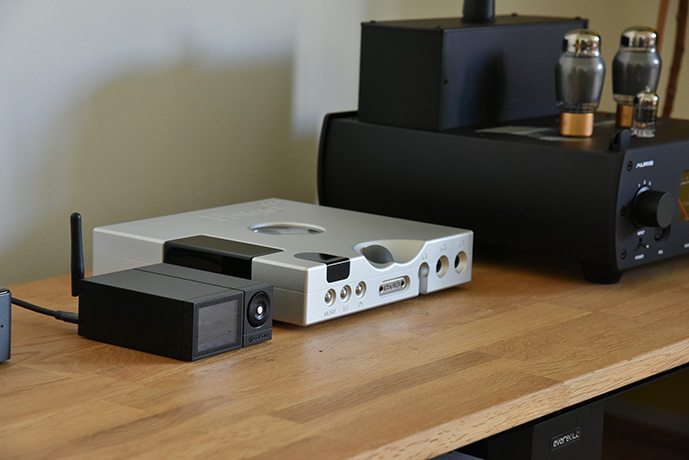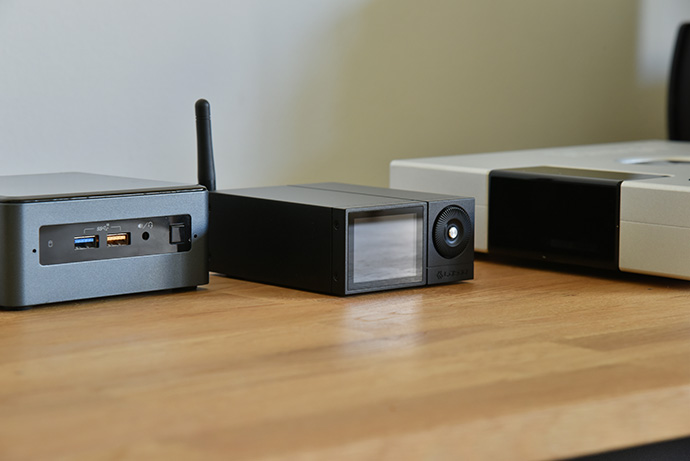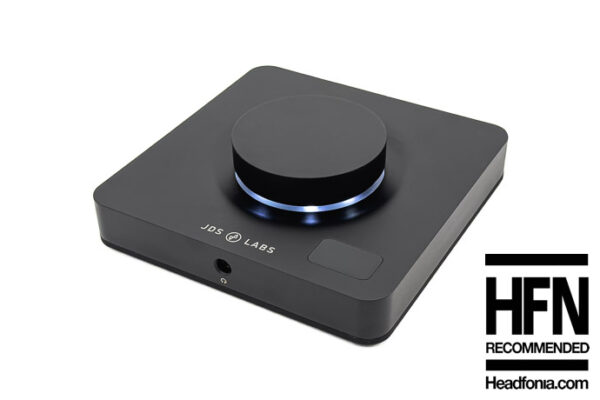If Google brought you here directly, jump back to page one!
Usability
The PAW D3 does not have a dedicated power supply but rather draws energy from the USB connection of your connected source. Once you connect the USB C cable to the unit, it will power up and show you all the information needed on the LCD screen.
You will see which mode you are currently using (DAC, LTTP), the sampling rate and bit depth of the current file playing, as well as the volume setting of the D3.
As mentioned before, the PAW D3 has multiple different use scenarios.
If you want to use the PAW D3 as a DDC you can simply hook up any digital source to any of the given inputs and connect the D3 to your external DAC.
Of course, you can also use the PAW D3 as a DAC itself and send the analogue signal to your amplifier or powered speakers.
When using the D3 as LTTP transmitter you will send the digital streams via Lotoo’s transfer protocol to an LTTP equipped device, such as the PAW Gold Touch 2 or the Mjölnir. In this case, you can send any incoming digital source via Lotoo’s wireless protocol to your secondary device. This basically is possible for any source with a digital output (TV, some turntables, CD players, etc).
By pressing the middle button of the volume wheel, you can access the settings menu of the PAW D3. Here you can adjust the output level, the working mode, the PEQ and ATE settings.
One thing I value very highly from Lotoo is their willingness to further improve their own software. They push new firmware releases throughout the year and add new features constantly.

Sound
During the past months I have used Lotoo’s PAW D3 as a DAC with my headphones or integrated amplifiers and as a digital converter for my external DACs. It was bundled with my Chord Hugo TT2 (as DDC), my Matrix Audio Element M2 (DDC) as well as with my Chord Alto and my Auris Audio Lyre (as DAC).
We will go over the sound signature of the PAW D3 as DAC before we will quickly jump to its DDC performance at the end of this segment.
The Lotoo PAW D3 has the typical Lotoo house-sound with a neutral presentation, where the key focus is on a plain signature with excellent levels of detailing and great imaging. The D3 has a lovely natural-neutral sound with good body and emotions but does not tilt towards neither warmth nor brightness. The PAW D3 is all about precision and accuracy.
Let’s explore a little further.
Lotoo’s PAW D3 has a neutral signature from top to bottom, so there is no exaggeration in any frequency range. Bass is well defined and comes with top quality body and precision. The PAW D3 gives bass a slightly above neutral body and shape but doesn’t push it forward in any way.
Lows are generally agile and tight, with a natural appearance. In terms of richness, we get a neutral presentation here as well. The PAW D3 has great resolution and texture in the lows, which shows best in acoustic music to me. Tracks like Brandt Brauer Frick’s Mi Corazon show this exemplarily well. Here the bass notes have superb definition and resolution, where you can distinguish small details very well.
In the lower midrange the PAW D3 has good body size and density, but it never leaves the impression of being too thick or slow due to its weight. There is a very slight amount of warmth in the midrange in general, but don’t expect the D3 to be a tube’ish warm experience, as this is absolutely not the case.
The D3 puts in its warmth just to give the music a more natural and organic sound without ever losing its neutrality focus.
What I like most about the D3’s midrange is its level of resolution and perfection in a natural reproduction. Instruments and singers all sound realistic, even if they might miss out on a bit of richness for that oozing flavor. On the other hand, you can always color your sound on later stages of the chain, which is my preferred modus operandi.
The PAW D3 possesses excellent technical performance, where the key is resolution and imaging in my opinion. The Lotoo brings out heaps of details and information from the fed input signal. You get a dark background with a good contrast between the back and musicians in front. The D3 paints a clear and clean picture where you can pinpoint each instrument on the stage with ease.
The soundstage is more focused, and some might perceive it as a shoebox style stage with better depth than width.
The Lotoo’s impressive ability to render complex images shows very well with music that’s traditionally more overloaded with information, like orchestras or big bands. One track that I always like to come to for testing is Powerplant’s cover of Kraftwerk’s Tour de France.
In the treble Lotoo’s PAW D3 plays the same neutral game as in all other frequencies. It doesn’t push too much lower treble to become piercing. It shimmers with good brightness but doesn’t produce any discomfort in any way to me. Cymbal crashes, high pitched strings and instruments have a neutral sound with good body and agility.
The treble pushes great levels of air into the rest of the spectrum to give musicians and instruments the needed space around them to breathe.
Now that we know how the Lotoo PAW D3 sounds as a DAC, let’s quickly check out how it performs as a DDC. Spoiler alert: very well!
When I connected the coaxial output to my Hugo TT2 I immediately noticed the enhanced rendering and resolution. The imaging stepped up with enhanced values in contrast, where the background got darker and the musicians were highlighted sharper. I also noticed a slightly wider soundstage, but it was especially the depth that saw improvements.
The Hugo TT2 is a resolution monster on its own, but with the PAW D3 in the mix, it even went a step further.

Conclusion
Lotoo has created a wonderful device with the PAW D3. It is a great DAC for the price, but it even impressed me more as a DDC where all my high-end DACs made a noticeable jump in sound quality. Even as a very niche product, the PAW D3 offers great audio value and improves my system further.
The PAW D3 comes with Lotoo’s traditional tuning philosophy where a natural-neutral sound is key. For those that wish for more bass or treble, they can always make use of Lotoo’s fantastic parametric EQ and shape the sound to their preferences.
To me, the PAW D3 is an excellent option for anyone who’s looking to further improve their existing chain. Especially as a digital-to-digital converter it convinced me a lot!
Summary
Pros:
Superb Build Quality
Neutral-natural sound
Powerful PEQ and ATE filters
Excellent performance as DDC
True lossless over wireless (LTTP)
Cons:
Limited sampling rate support
Proprietary LTTP protocol not widespread in audio (yet?)









